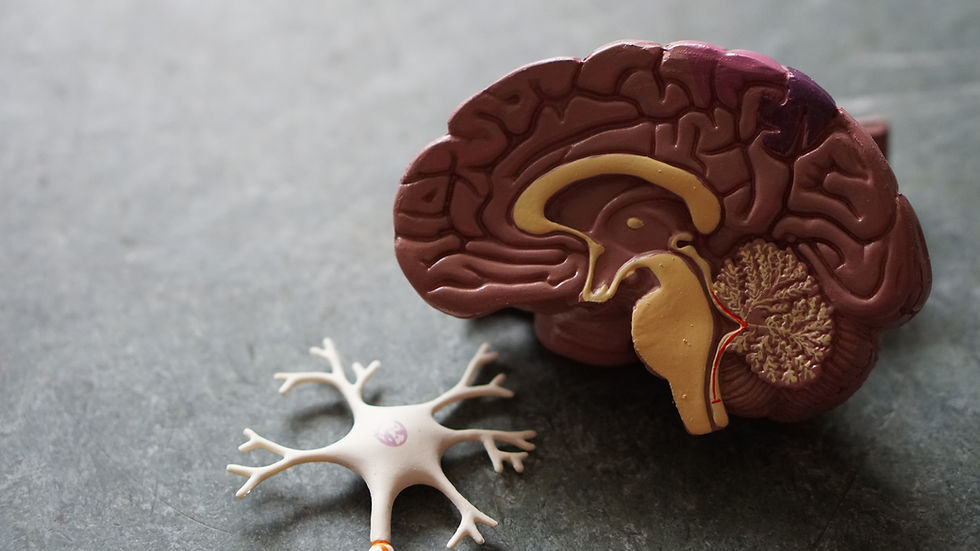Alzheimer's disease: Causes, Risks, and Prevention
- Lauren Barkley
- Jun 5, 2024
- 3 min read

Alzheimer’s Disease (AD) is an incurable neurodegenerative disease that impacts one’s memory, mood, sleep, and all aspects of life as it progresses. There are multiple neurodegenerative diseases (e.g. Parkinson’s Disease, Huntington’s Disease, Amyotrophic Lateral Sclerosis), however, AD constitutes the highest percentage of all neurodegenerative diseases at 60-80% (Reitz et al., 2011; Mayeux and Stern, 2012; Sosa-Ortiz et al., 2012 qt. in Erkkinen et al., 2018). So what exactly is a neurodegenerative disease? What factors increase or decrease one’s chance of getting AD?
AD occurs via two abnormalities in neuronal cells which do not regenerate in the brain and spinal cord (making AD “neurodegenerative”). Outside the neuron, plaques of amyloid precursor protein byproducts accumulate; inside the neuron, tau proteins form tangles due to problems with their normal production. Both of these processes cause neurons to die. Neuronal death causes cognitive and physical symptoms that ultimately lead to death (Erkkinen et al., 2018). Because AD is a progressive disease that can occur for years, its symptoms are surprisingly variable. Interestingly, some individuals with amyloid plaques and tau tangles never develop AD (Zhang et al., 2021). This is due in part to AD being diagnosed as symptoms appear, most notably when memory loss happens.
Current treatments are available to target amyloid plaques, tau tangles, and cognitive symptoms of AD (Alzheimer’s Association, 2019). Cognitive symptoms associated with AD are memory loss, depression and anxiety, sleep disturbances, and aggression. For these symptoms, sleep medications and antipsychotic medications can be helpful (Alzheimer’s Association, 2019). Unfortunately, none of these medications cure AD; they simply treat AD’s symptoms or slow the progression of neuronal death from AD. Despite both amyloid plaques and tau tangles being hallmarks of AD, there is a higher association between tau tangles and neuropsychological deficits (Congdon and Sigurdsson, 2018). Thus, it is increasingly important to develop drugs that target tau tangles specifically and effectively.
Risk factors for AD include smoking, diabetes, hyperlipidemia, obesity, and experiencing a traumatic brain injury (e.g. concussions or contusions). All of these risk factors increase your risk of contracting AD twofold (Erkkinen et al., 2018). Genetically, possessing the 𝜀4 variant of the ApoE gene increases your risk of AD, especially if you are female (Erkkinen et al., 2018). Protective factors against AD include maintaining low to moderate caffeine and alcohol use, exercise, a ketogenic diet, and having a diet rich in omega-3 fatty acids. Social factors also impact your AD risk; being married, bilingual, well-educated, and having sufficient social engagement all lower one’s risk of AD (Zhang et al., 2021). It is incredibly important that we maintain social engagement as we age.
Lastly, it is important to note that AD primarily affects the elderly and has a small likelihood of occurring via genetic means (Erkkinen et al., 2018). Shockingly, one in three people above age 85 has AD (Alzheimer’s Association, 2023). Thus, what you do can either increase or decrease your risk of contracting AD. Furthermore, the number of individuals with AD is rapidly increasing, especially in the Global South, so much so that approximately 152 million people will have AD in 2050 (Zhang et al., 2021). This is due in part to people living longer with the disease as treatments improve. This staggering number of AD patients must inspire new research, new medications, and new treatment plans.
Works Cited
Alzheimer's Association contributors. (2019). Treatments and Research. Alzheimer’s Disease and Dementia; Alzheimer’s Association. https://www.alz.org/help-support/i-have-alz/treatments-research
Alzheimer's Association contributors. (2023). 2023 Alzheimer’s disease facts and figures. Alzheimer’s & Dementia, 19(4), 1598–1695. https://doi.org/10.1002/alz.13016
Congdon, E. E., & Sigurdsson, E. M. (2018). Tau-targeting therapies for Alzheimer disease. Nature Reviews Neurology, 14(7), 399–415. PubMed. https://doi.org/10.1038/s41582-018-0013-z
Erkkinen, M. G., Kim, M.-O., & Geschwind, M. D. (2018). Clinical Neurology and Epidemiology of the Major Neurodegenerative Diseases. Cold Spring Harbor Perspectives in Biology, 10(4). PubMed. https://doi.org/10.1101/cshperspect.a033118
Zhang, X.-X. ., Tian, Y., Wang, Z.-T. ., Ma, Y.-H. ., Tan, L., & Yu, J.-T. . (2021). The Epidemiology of Alzheimer’s Disease Modifiable Risk Factors and Prevention. The Journal of Prevention of Alzheimer’s Disease, 8(8), 1–9. PubMed. https://doi.org/10.14283/jpad.2021.15 Assessed and Endorsed by the MedReport Medical Review Board

